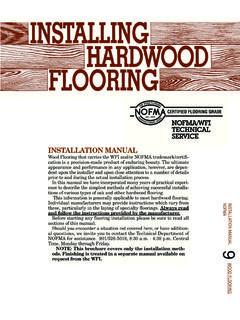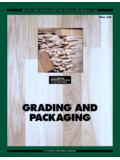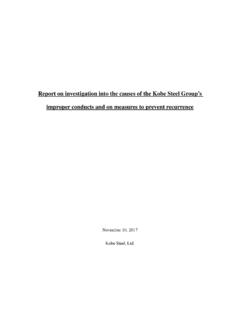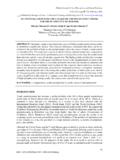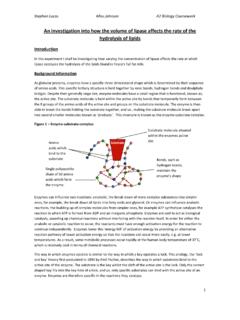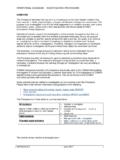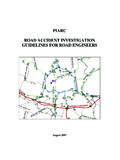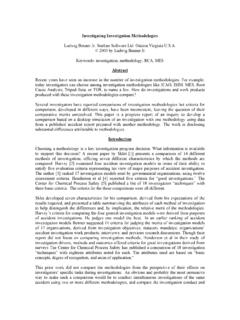Transcription of PROBLEMS, CAUSES, AND CURES - Crescent Hardwood
1 2002 NATIONAL WOOD FLOORING ASSOCIATIONNATIONAL WOOD FLOORING ASSOCIATION TECHNICAL PUBLICATION No. C200 Price: $30 PROBLEMS, causes ANDCURESOF Hardwood FLOORS2 2002 NATIONAL WOOD FLOORING ASSOCIATIONNATIONAL WOOD FLOORING ASSOCIATION TECHNICAL PUBLICATION No. C200 CONTENTSPROBLEMS, causes , AND CURES3 INTRODUCTIONHow to inspect a floorTools for inspectionDetermine the problem Find the cause Questions for the consumerQuestions about the history of thejob siteQuestions about the job site at thetime of inspection Questions about the home s exteriorQuestions about the history of thewood flooringRecommend the repair6 JOB-SITE PROBLEMSB ucklingChatter/Wave MarksCrowningCuppingDentsDish OutFlooded FloorsGaps, NormalGaps, AbnormalGrade ProblemsGreenhouse EffectInsectsPicture Framing ( Halo )Shellout/Dishing of SpringwoodSlivers/SplintersSqueaky/Loose Floors ( Popping )
2 Sticker StainUnevenness of Entire Floor11 FINISH PROBLEMSA lligatoringApplicator StreaksBleed BackBubblesChippingCloudy FinishCrateringDiscolorationExcessive/Ea rly Finish WearFisheyes/CrawlingIridescent FinishOrange PeelPeelingPin HolesPoly BeadsRoughness/Grain RaiseSidebonding/PanelizationStainsStick y Board SyndromeUneven Sheen Levels16 APPENDIXU nderstanding WoodThe Structure and Composition ofWoodRelative Humidity and the Wood-Moisture Relationship17 INDEX18 SOURCES AND CREDITS19 RESOURCESNO GUARANTEE OR WARRANTYThe information contained in this publication represents widely accepted industry practices. There are, however, no universally approvedmethods of troubleshooting wood floors.
3 The National Wood Flooring Association accepts no risk or liability for application of theinformation contained in this publication. 2002 NATIONAL WOOD FLOORING ASSOCIATION3 NATIONAL WOOD FLOORING ASSOCIATION TECHNICAL PUBLICATION No. C200 IntroductionIn a perfect world, this technical manual wouldn tbe necessary. Every wood flooring installationwould be flawless, every contractor would get paid,and every customer would be happy. Of course,that is not the case. Many variables go into theinstallation, sanding and finishing of hardwoodfloors, and sometimes things go wrong. However,even when there is a problem , the floor doesn t haveto be a failure.
4 If the cause can be pinpointed andcorrected in a timely, professional manner, the con-tractor still can have a satisfied to Inspect a FloorJust as no two floors are the same, the inspectionprocess varies for each floor problem . However, thereare three basic goals every time you go to inspect afloor: determine what the problem is, find the causeof the problem and recommend how to repair thefloor. Sometimes the details on the necessary repairmay by out of the scope of your expertise ( , joistproblems, site drainage).Tools for inspection moisture meter(s) (for wood and concrete):to getan average reading of the flooring moisture contentpercentage, and also to get an average reading atvarious levels through the wood floor and subfloor(for the latter, moisture meters with 11 8-inch pinsare commonly used).
5 Electronic hygrometer/thermometer:to mea-sure temperature, relative humidity and dew point. tape measure:to measure distances, aggregatewidths of strips, etc. pocket knife or depth gauge:can be insertedbetween boards to determine the wear layer depth. flashlight:to look in crawlspaces. Also can beused to throw shadows to determine if a single stripis moving up and down. magnetic stud finder:to locate flooring nails. hammer:to drive in moisture meter probes andaid in removing flooring samples. blade and Phillips screwdrivers:to scrape and prywith. Also useful for working on moisture meters. 1-inch wood chisel:to aid in removal of samplematerials.
6 Thin feeler gauge or taper gauge:both areused to measure the width of gaps. The taper gaugeis easier to use. notepad and pen/pencil:to record data. micrometer:to measure the width of the materi-als for comparison to original manufactured width. camera(digital preferred):to create a visualrecord of observations. thermometer:for checking surface hygrometers also may do this. string(about 15 feet):can be pulled taut acrossboards to determine if the floor is flat. lit magnifying glass:commonly available at elec-tronics stores, this is useful for seeing scratch pat-terns and debris on the the problemThe first step in the inspection is talking to theclient to discover exactly what he or she is unhappyabout.
7 Sometimes floors that are a problem to thecustomer look perfectly acceptable to the woodflooring contractor. Such situations often are a caseof misunderstood customer handling complaints from unhappyclients is probably your least favorite aspect ofbeing a wood flooring contractor, there are stepsyou can take to minimize the grief involved, espe-cially when customers are really angry. Here aresome things to keep in mind when meeting with theunhappy client: for the few professional complain-ers who use complaints to avoid contractualobligations, most clients first need to vent theirfrustration and you need to know the , listen all the way through customers remarks, even if they become offensive.
8 Clientsmay feel that to get some attention, they mustshout at somebody. Let that happen. Afterwards,they probably will be easier to deal with. Be take a complaint person-ally not even a tirade. You can express your con-cern without taking sides, even if you later mustdispute much of the customer s view of the prob-lem. You can t blame the owners for wanting theproblem fixed. Be not allow emotions or priorknowledge to get in the way of handling facts asfacts. There is no percentage in arguing. Just col-lect all the facts. By the same token, keep in mindPROBLEMS, CAUSESAND CURES4 2002 NATIONAL WOOD FLOORING ASSOCIATIONNATIONAL WOOD FLOORING ASSOCIATION TECHNICAL PUBLICATION No.
9 C200that a few boards do not always make a legitimatecomplaint. Log all written records through-out the project, from the first contact through afull inspection. Initially, get all pertinent data suchas owner s name, address and phone, plus thesame information on the builder, retailer or con-tractor; what the product is; brand; when pur-chased; quantity, when installed and whenfinished. And get a full description of the problemat the outset. Inspect the floor as soon as cancreate a second complaint and do little for yourcredibility. Do not make a snap judgment of theproblem and, above all, do not report your find-ings on the spot to the client, builder, or any otherinterested the causeOnce you have defined what the problem is, it stime to do the detective work and determine whythe problem happened (or still is happening).
10 Sometimes this is cut-and-dried such as whenyou see a big footprint in the topcoat. More often,rooting out the cause takes more following is a detailed list of standard thingsto consider when inspecting a floor. Of course, notall details are necessary for every inspection, butthey all are possible factors in a problem floor. Ifyou re the one who installed the floor, the trou-bleshooting may be easier. If you re trying to followup on someone else s failed floor, it may take amore detailed of the following questions relate to themost common culprit when dealing with woodflooring problems moisture. For further informa-tion on moisture and wood flooring, refer toNWFA sTechnical Publication No.

